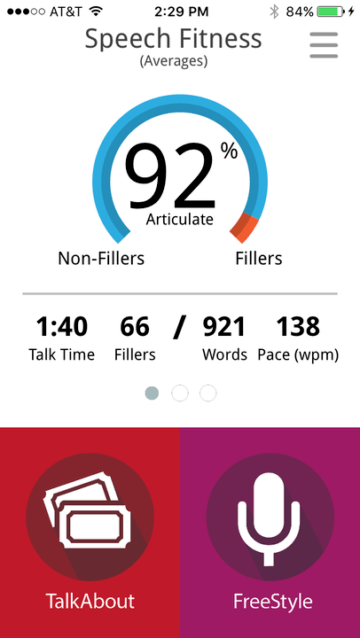I recall one time, in college, I had to deliver a presentation on a topic, and the person before me was so pro, and covered so much of what I intended to cover, that I was left there, in front of the class mumbling and stumbling my pre-prepared speech. Fear of public speaking (Glossophobia) is so common that a stunning 75% of people suffer from it.[2] Of course, fear of public speaking is only one aspect of why delivering a great presentation can be tough. You may find yourself having to condense weeks of research and pages of information and data into only a handful of minutes. On top of this you could worry about the format and structure of your presentation (this is a big issue for me). As it is important for professional or academic success, all these stresses can make presentations seem nightmarish. But they don’t need to be. In fact, your presentation and public speaking skills can be improved tenfold thanks to a handful of tips and considerations. Many, many books have been published about tackling public speaking, many therapists specialize on helping people with this anxiety (of course, if you feel like seeing one may help, go for it!) but great improvement can be made without too much effort. See the tips below.
Drop Verbal Fillers
Every-day conversation and talk is actually pretty strange if you really pay attention and focus on it. We speak in run on sentences, sometimes don’t quite make sense, make points that don’t lead anywhere, and most of all, fill our talks with little verbal ticks and filler words.[3] Filler words fill our spoken sentences with words like “um”, “ah” “like”, and “you know?” words, that don’t mean anything, and are only there so you can keep making a sound when you figure out what to say next. Its perfectly natural and pretty much everyone does them. We are all so accustomed these elements of casual conversation that we don’t notice them. However during a high pressure activity like delivering a presentation we can start to become really aware of it all, and start to kick ourselves for making them. Whats worse, is that they may have a genuinely negative effect on our presentations. The solution? Get rid of them. But how? A good tip is to record yourself in numerous conversations, then repeatedly listen to them. This will make you much more aware of how you use filler words and will be good step towards dropping them. Though we don’t like silences, sometimes not saying something for a second, and taking a breath may make you sound more confident than filling your presentations with fillers. If you need a little bit more help, there is actually an app designed to coach you out of using filler words called Likeso. [4]The app is programmed to pick up your use of filler words when you talk and reveal them to you as a percentage of your overall speech. Getting rid of filler words will also improve your communication skills generally and make you much more articulate, merely by clearing away unnecessary filler.
Inform, Educate, and Entertain
These three intentions should be core to your presentation. The same ideas were the foundation of the BBC, and were big parts of all of Steve Jobs ‘ presentations and product launches.[5] Entertaining those viewing your presentation (perhaps by adding an element of humor to your presentation or other elements) will ensure they won’t be bored during your presentation. Also if you entertain well, they will be drawn to you. Informing and educating is where you convey the substance of your presentation.
Practice, Practice, Practice
This is by far the most obvious bit of advice, but it is also by far the most important. Before delivering your presentation, you need to know it backwards, forwards, left right, up down, every way. If you can, try to memorize as much as possible. This might both help with nerves, but also make you come across as more confident and knowledgeable. People are naturally drawn to those they perceive as confident. So, if you deliver your presentation with confidence brought from practice, you may turn those people you’re presenting to, from intimidating judges, to a captivated audience. When practicing consider not only the words you’re saying, but how you’re saying them, and your movements and posture. A presentation is pretty much a performance. A piece of theater, and you are the lead actor.
Consider your body language
Though we tend to think that communication is all about what we say, and perhaps tone. It is thought that 94% [6] of how we communicate is actually non verbal, this is a myth, however your gestures and body language are important parts of your communication.[7] You could be delivering the most beautifully written presentation ever, but if you deliver it without moving, timidly in the corner with your hands in your pockets. You will seem uninspired and well..boring.
The good news is, gesturing is perfectly natural, if you make effort to deliver your conversation with confidence, this will show itself in your gestures.[8] All you need to really do is loosen up and the rest will take care of itself. If we begin to pay attention to our use of gestures, we may initially begin to feel a bit self conscious and may fight the natural urge to gesture. Don’t pay attention to these feelings, and your presentation will be all the better for it.
Don’t be afraid to bring in sources and ideas that aren’t directly relevant
This really only works in presentations when you have a decent amount of time in a presentation. But if a part of your presentation reminds you of something in history, science, or literature and it seems relevant. Don’t be afraid to work it into the presentation. Mark Levy, president of the branding firm Levy Innovation,[9] and the writer of Accidental Genius: Using Writing to Generate Your Best Ideas, Insight and Content[10] says the following : This makes sense, after all, why are books like Machiavelli’s The Prince or Sun Tzu’s The Art of War still so popular? I don’t believe its because Renaissance era Florentine politics and ancient Chinese warfare are common interests. But instead the lessons contained within (though I’d be wary of those who pay too much attention to Machiavelli) have been used and adapted successfully by those in business.
Whether to read out loud?
The advantages of reading your presentation from a pre-written script are at first, pretty clear. Focusing on the script will ensure everything you say is valid and appropriate, will help eliminate filler words as you no longer need to think about what to say, and means you don’t need to spend the whole time looking at everyone’s faces and wonder what they’re thinking. The advantages are obvious…however they are deceptive. It is always a good idea to have something on hand like a script or sheet of notes. However, relying on notes or a script completely will suck out all life from your presentation. Also if you are just standing there and reading, you will seem as if you haven’t practiced, and by extension have little interest or knowledge in what you are presenting. This can kill off your presentation entirely. As such, if you don’t think you can memorize the whole thing, you should work hard to find a good mid point. Featured photo credit: Judson University via flickr.com

